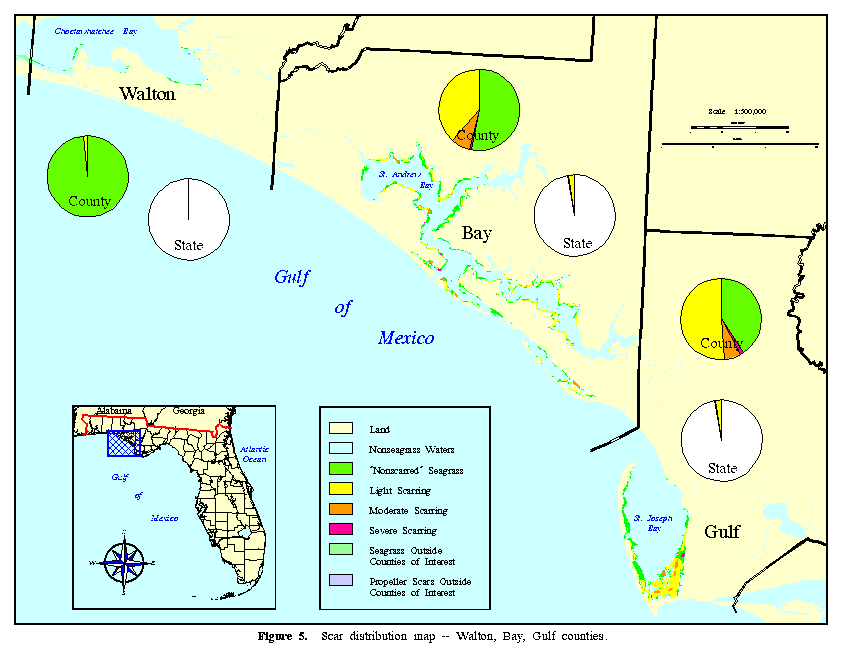
Seagrasses are a vital component of Florida's coastal ecology and economy; they provide marine fauna with improved water quality, nursery grounds, shelter, and nutrition. As the state's human population grows, threats to the health and very existence of these ecological communities increase. Habitat degradation has many sources (e.g., pollution, dredge and fill), but an increasingly common cause is scarring of seagrasses. Scarring occurs when propellers damage seagrass beds by ripping up shoots and rhizomes (roots) and exposing the bottom sediment. In this paper, scarring can refer to either the activity of scarring or the area containing a group of scars.
The Florida Department of Environmental Protection (DEP) recognized the need to reduce scarring of seagrasses by boats and committed resources to address this issue. As one component of this effort, the Florida Marine Research Institute (FMRI) investigated the distribution of scarred seagrass beds in the shallow marine and estuarine waters of Florida's coastal counties. Aerial photography was used to locate areas of scarring. Aerial surveys were then conducted in 1992-1993 to confirm and amend the demarcation of scarred seagrasses.
Scarring intensity was categorized as light, moderate, or severe. Polygons categorized as light contained less than 5 percent scarring, those categorized as moderate contained 5-20 percent scarring, and those categorized as severe contained greater then 20 percent scarring. The information acquired in this survey was incorporated into the FMRI's Marine Resources Geographic Information System (MRGIS), which when analyzed were used to produce maps and tabular products for use by resource managers, regional and county governments, and other interested parties.
INTRODUCTION Seagrasses are completely submerged, grass-like plants that occur mostly in shallow marine and estuarine waters. The predominant seagrass species in Florida (Figure 1) are turtle-grass (Thalassia testudinum Banks ex Koenig), shoal-grass (Halodule wrightii Ashers.), and manatee-grass (Syringodium filiforme Kutz.). Other less common seagrasses--star-grass (Halophila engelmannii Ashers.), paddle-grass (Halophila decipiens Ost.), Johnson's seagrass (Halophila johnsonii Eisem.), and widgeon-grass (Ruppia maritima L.)--may be locally abundant. In areas subject to salinity fluctuations, such as river mouths, other submerged aquatic plant species (e.g., Zannichellia sp. and Najas sp.) may occupy an ecological role similar to that of the true marine and estuarine seagrasses.
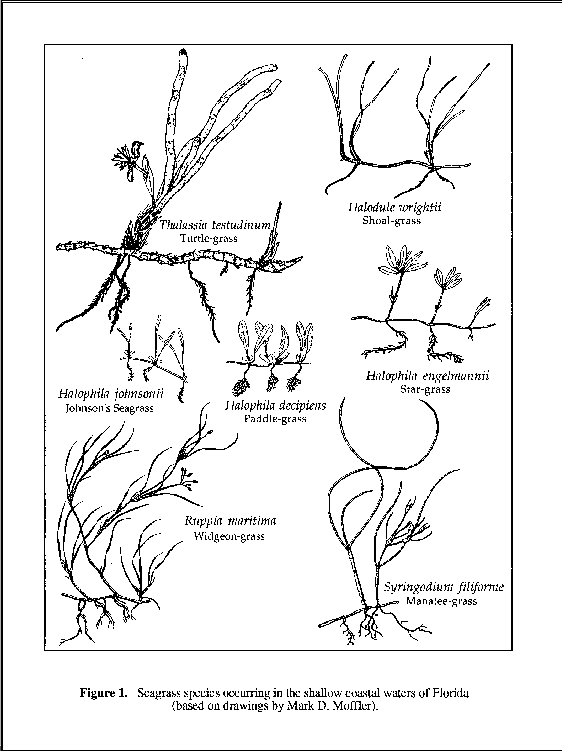
Seagrasses form some of the most productive communities in the world (Zieman and Zieman, 1989) and are aesthetically and economically valuable to humans. These complex, fragile communities benefit marine and estuarine animals--especially larval and juvenile fish--by providing critical shelter and sustenance. In addition, seagrasses improve water quality by stabilizing mobile sediments and by incorporating some pollutants into plant biomass and into the stabilized sediments. As Florida's population increases, particularly in coastal counties, threats to seagrass communities increase (Livingston 1987). Seagrass losses in Florida have been documented to range from 30 percent in the Indian River Lagoon (Haddad and Harris 1985) to 81 percent in Tampa Bay (Lewis et al. 1985). The cumulative effects of anthropogenic threats (e.g., water pollution, docks, dredging and filling) are being addressed by various federal, state, and local resource management programs. One threat that is becoming more acute, as people increasingly use boats and other watercraft for recreation and work, is scarring of seagrasses. In this paper, scarring can refer to either the activity of scarring or to a group of scars in a seagrass bed. The most common type of scarring to seagrasses is caused by small-boat propellers; however, larger craft, which are usually confined to deeper waters, may have much larger individual effects when they run aground, especially near shipping channels and ports. Propellers damage seagrass beds by ripping up shoots and rhizomes (roots) and exposing the bottom sediment. Nearly all shallow seagrass beds in Florida show damage caused by boat propellers. Recovery and regrowth of seagrasses from such damage can take years (Durako et al. 1992). Extensive scarring may expose the beds to further disruption from storms and other natural erosional forces, thereby increasing the rate of cumulative loss. Similarly, resuspension of sediments in the water column, may further contribute to habitat loss by inhibiting the growth of seagrasses. Study Objective Concerns about the effects of seagrass scarring and recovery on marine productivity compelled the Florida Marine Research Institute (FMRI) to conduct a general survey of the extent and intensity of seagrass scarring in the shallow coastal waters of Florida. We collected and analyzed the data using a combination of aerial photography, aerial surveys, and Geographic Information System (GIS) technology. For the first time, the statewide extent of seagrasses was described, and the magnitude of scarring was estimated and documented so that Florida's seagrass resources can be more effectively protected. Further investigations and surveys using developing technologies will refine our knowledge of seagrass distributions and the effects of human activities on the resource's productivity. METHODS The study area extended from the Alabama-Florida border at Perdido Bay (Escambia County), east and south along the Gulf coast to the Florida Keys, and then north along the lagoonal river systems of the Atlantic Coast to just south of New Smyrna Beach (Volusia County) in Mosquito Lagoon. A total of 31 of the state's 35 coastal counties are included in this survey (Figure 2). The four counties north of Volusia County on the Atlantic coast of Florida were not included because areas suitable for seagrass growth are not present. Only the southern part of Volusia County below U.S. Highway A1A at Port Orange was included in this survey.
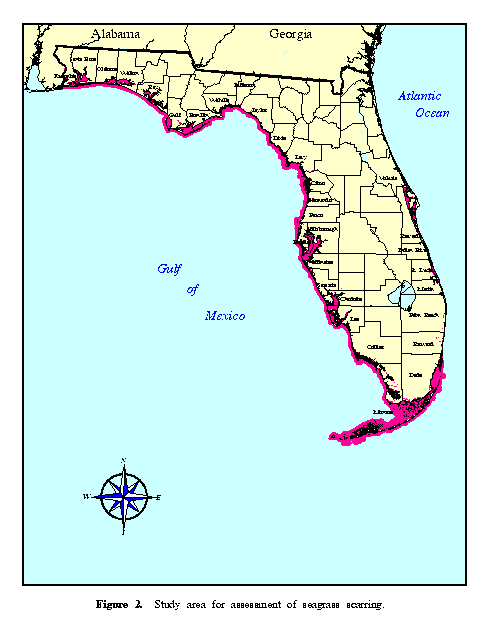
To cover such a large geographic area, we used an approach combining analysis of high-resolution aerial photographs with ground- truthing during aerial surveys. In the Florida Keys, the aerial surveys were conducted first, and aerial photography was used as collateral data. The aerial photography provide sufficient detail to allow recognition of prop scars, however, high-resolution photography was limited. Where available, pertinent photography not contained in the FMRI library were obtained from the appropriate water-management districts. The largest-scale aerial photography used were the 1:13,200 color- infrared (CIR) transparencies collected for the Florida Keys Land Cover Mapping Project (funded by the U.S. Environmental Protection Agency's Advanced Identification of Wetlands Program) in December 1991. The smallest-scale photography used consisted of 1:40,000 CIR transparencies provided by the South Florida Water Management District (SFWMD). The oldest photographs used for scarring delineation were taken in November 1990. Although these photographs did not represent conditions at the time of the survey, historical scarring patterns were documented from them, and areas requiring closer examination were identified. Scarring Recognition We did not distinguish among the various scarring sources nor map individual prop-scars. A bounding polygon was drawn around groups of scars that had a map area greater than one acre. The intensity of scarring in each polygon was categorized based upon the Comparison Chart for Visual Estimation of Percentage Composition (after Terry and Chilingar 1955). Polygons designated as light enclosed areas where less than 5 percent of the seagrasses were scarred, moderate polygons contained areas with from 5 percent to 20 percent scarring, and severe polygons delineated areas with more than 20 percent scarring. Diagrammatic representations of the three categories of estimated scarring intensity are shown in Figure 3. In some areas, different intensities of scarring were adjacent and could not be easily differentiated. These areas were delineated as a single polygon and were assigned a value for the overall scarring intensity.
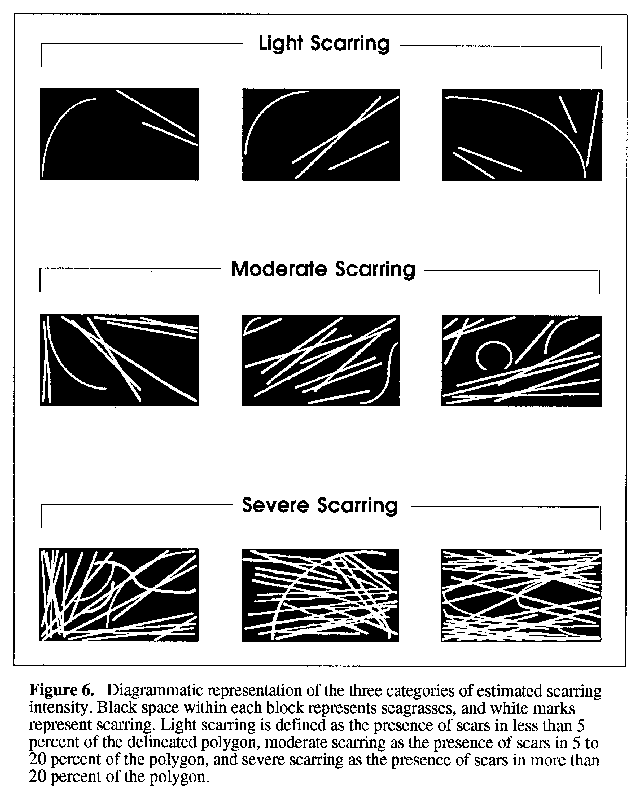
Polygons drawn on the registered overlays on the aerial photographs were transferred to National Oceanic and Atmospheric Administration (NOAA) nautical charts using a zoom transfer scope (ZTS). The ZTS superimposes an image onto a base map of a different scale, providing for accurate transfer of the hand-drawn polygons from the photograph overlays onto the NOAA base maps. In most cases, 1:40,000-scale NOAA charts were used as base maps. The lack of larger-scale charts for the region from Anclote Key (Pasco County) to Alligator Harbor (Franklin County) forced us to use 1:80,000-scale charts. When possible, we used inset maps of various scales (1:5,000-1:20,000) to supplement small-scale chart information. In a portion of the Florida Keys, 1:24,000-scale U. S. Geological Survey (USGS) quadrangle maps were used as base maps because the largest-scale NOAA charts were only available at a scale of 1:80,000 (Table 1). Table 1. NOAA nautical charts and USGS topographic maps used as base maps on which seagrass scarring in Florida was represented. Number Scale Official Name Chart 11378 1:40,000 Intracoastal Waterway - Santa Rosa Sound to Dauphin Island Chart 11393 1:40,000 Intracoastal Waterway - Lake Wimico to East Bay Chart 11402 1:40,000 Intracoastal Waterway - Apalachicola to Lake Wimico Chart 11404 1:40,000 Intracoastal Waterway - Carrabelle to Apalachicola Bay Chart 11405 1:80,000 Apalachee Bay Chart 11407 1:80,000 Horseshoe Point to Rock Islands Chart 11408 1:80,000 Crystal River to Horseshoe Point Chart 11409 1:80,000 Anclote Keys to Crystal River Chart 11412 1:80,000 Tampa Bay and St. Joseph Sound Chart 11413 1:40,000 Tampa Bay - northern part Chart 11414 1:40,000 Tampa Bay - southern part Chart 11425 1:40,000 Intracoastal Waterway - Charlotte Harbor to Tampa Bay Chart 11427 1:40,000 Intracoastal Waterway - Fort Myers to Charlotte Harbor Chart 11430 1:40,000 Everglades National Park - Lostmans River to Wiggins Pass Chart 11432 1:50,000 Everglades National Park - Shark River to Lostmans River Chart 11433 1:50,000 Everglades National Park - Whitewater Bay Chart 11441 1:30,000 Key West Harbor and approaches Chart 11442 1:80,000 Sombrero Key to Sand Key Chart 11445 1:40,000 Intracoastal Waterway - Bahia Honda to Key West Chart 11448 1:40,000 Intracoastal Waterway - Big Spanish Channel to Johnson Key Chart 11449 1:40,000 Matecumbe to Bahia Honda Key Chart 11451 1:80,000 Miami to Marathon and Florida Bay Chart 11463 1:40,000 Intracoastal Waterway - Elliott Key to Matecumbe Chart 11465 1:40,000 Intracoastal Waterway - Miami to Elliott Key Chart 11467 1:40,000 Intracoastal Waterway - West Palm Beach to Miami Chart 11485 1:40,000 Intracoastal Waterway - Tolomato River to Palm Shores USGS map 1:24,000 Marquesas Keys West USGS map 1:24,000 Marquesas Keys East USGS map 1:24,000 Cottrell Key USGS map 1:24,000 Key West Scar Mapping and MRGIS Integration After marking the maps and charts with polygons, we conducted aerial surveys to verify scarring and refine the delineations of scarring intensity. Most aerial surveys were conducted between May 1992 and May 1993. The Florida Keys surveys were conducted between October 1992 and March 1993. Information about seagrass scarring in Florida Bay was furnished by Skip Snow of the Everglades National Park (ENP). Within Florida Bay, scarring occurs principally on seagrass banks, which are exposed at low tide. To confirm the locations of scarred seagrasses, a brief aerial survey was conducted by FMRI staff over a portion of Florida Bay. Aerial surveys were important in assuring accurate representations of the extent and intensity of scarring because even in the better photographs, not all scars were visible. In regions where seagrasses were distributed along relatively straight and continuous shorelines, such as the Indian River Lagoon, the southeast Intracoastal Waterway, and the Florida Keys, surveys were conducted from light, fixed-wing aircraft (Cessna 152 or 172). Regions with convoluted shorelines and numerous islands, such as Tampa Bay, Biscayne Bay, Waccasassa Bay, and parts of Florida Bay, were surveyed from a helicopter (Hughes 500). In the lower Florida Keys, where wide areas of seagrass extend from the Atlantic Ocean into Florida Bay, transects approximately 1000 feet apart were conducted perpendicular to the main axis of the Florida Keys. Military bases prohibited aerial surveys of some seagrass areas. Upon completion of the aerial surveys, we edited and recompiled the scarring data onto a clean set of base maps and then transferred the data into the Marine Resources Geographic Information System (MRGIS) at the FMRI. The final data taken from paper maps and charts were integrated into the Marine Resources GIS (MRGIS) at the Florida Marine Research Institute (FMRI) by the Coastal and Marine Resources Assessment (CAMRA) group. In consideration of the geographic extent of the study, the varied scales of the base maps, and the data-collection methodology, CAMRA staff determined that the data would be better represented as a single, statewide coverage with a scale of 1:40,000. The polygons delineating scarring were digitized and attributed to their appropriate scarring intensities. The resultant scarring coverage was registered to the 1:40,000-scale, state-wide shoreline coverage already within the MRGIS. Check plots were produced and compared to the original source maps to verify the presence and proper attribution of the polygons. Polygons that were inadvertently omitted from the coverage were added, and incorrect attributes were changed. A second iteration of this quality- assurance process was performed to ensure the completeness of these preliminary data on scarring. Next, we used the 1:40,000-scale land coverage to erase any portion of a polygon that had been drawn onto the land and subsequently digitized. Erase is an ArcInfo command that creates a new coverage by removing portions of the polygons from one coverage that are within an erase region. In this case, the polygons in the land coverage define that erase region, and the portions of the digitized polygons that overlapped the land were removed. This process was used to ensure the appropriate spatial coincidence between the polygons and the land features without having to digitize them. This minimized operator error on subsequent areal comparisons by ensuring coincidence of all arcs with other data sets contained in the MRGIS. Following the erase process, the resultant coverage was intersected with a modified county coverage and used to calculate acreages scarred by class and county. Intersect is one of several overlay commands available in ArcInfo. Intersect was used because the polygons in the coverage (input coverage) split where the polygons of the county boundaries (intersect coverage) overlap. Only those portions of polygons coincident between both input and intersect coverages were saved in the output coverage. All feature-attribute items from both coverages were carried in the attribute tables of the output coverage. If duplicate items were encountered, the item from the input coverage was maintained, and the one in the intersect coverage was dropped. The original county coverage was obtained from the 1990, 1:100,000 TIGER census data for the state of Florida. The shoreline features were removed, and where required, the county boundaries were extended offshore to enclose the data just created and all the existing seagrass-distribution data. On the Atlantic coast, the three-mile offshore extensions of the original County Jurisdictional Boundaries were sufficient to meet our standards. On the Gulf coast, county boundaries were extended out to the nine-mile State Jurisdictional line. For Dade and Monroe counties, the offshore lines required further extension to ensure enclosure of all mapped seagrasses. Creating a Statewide Seagrass Coverage A statewide seagrass database consisting of the most recent seagrass data available was assembled. Data were obtained from various sources and integrated into the MRGIS (Table 2). Disparate data collected were of various dates, scales, seagrass classifications, and formats. For example, seagrass classifications ranged from species-specific values for the density of bottom cover to unique coding schemes. Although data created in-house or by one of the water-management districts were in ArcInfo format, data from some sources were AutoCAD line files, which required conversion. This situation is not unique to this study. GIS and remote- sensing disciplines are currently investigating theoretical and technical difficulties associated with integrating data from disparate sources. Table 2. Sources of data used to compile seagrass distributions for the 31 Florida coastal counties in this study. Coverage Name* Date Source(s) and Scale Pangrass 1982 FDEP 1:24,000 scale NC aerials (Alabama to
Apalachee Bay) 1985 1:58,000 scale CIR aerials Bendgrass 1983 MMS 1:40,000 scale NC aerials (Apalachee Bay to St. Joseph Sound) Tbaygrass 1990 SWFWMD 1:24,000 scale NC aerials (St. Joseph Sound to Sarasota Bay) Lemgrass 1987 Mangrove 1:24,000 scale Aerial Photography (Lemon Bay) Systems Inc.
(Digitized into ERDAS at a scale of 1:40,000) Chargrass 1982 FDEP/FDOT 1:24,000 scale Aerial Photography (Charlotte Harbor to Estero Bay) Sfgrass 1988 MMS "Southwest Florida Nearshore Benthic (Everglades to Biscayne Bay) Habitat Study" maps (1:40,000) 1982 Marszalek "Florida Reef Tract Marine Habitats and Ecosystems" maps (1:40,000) 1983 Dade "Benthic Communities County of Biscayne Bay" map (1:40,000) 1987 FDEP 1:40,000 scale NC aerials (data gaps were filled in-house) Palmgrass 1990 Palm Beach AutoCAD line files (Palm Beach County) County (converted to ArcInfo by FDEP in 1994) Irlgrass 1992 SJRWMD 1:24,000 scale CIR aerials (Jupiter Inlet to Mosquito Lagoon) * Identify the name for seagrass-coverage data in the Marine Resources Geographic Information System (MRGIS) at the Florida Marine Research Institute (FMRI). NC--reference for natural color; CIR--reference for color infrared Some seagrass source data were distorted and required correction (e.g., data for Charlotte Harbor and the Big Bend region). In addition to correcting existing seagrass data sets and integrating non-ArcInfo data, several gaps in the statewide seagrass-data coverage were identified and filled. Data needs for the area from Indian Rocks Beach to Anclote Key and a portion of Sarasota Bay were filled using 1990 SWFWMD 1:24,000- scale CIR aerials. Some minor gaps in the seagrass data from south Florida and the southern half of Estero Bay were interpreted from 1:24,000-scale CIR aerials borrowed from the SFWMD. Sparse and hardbottom seagrasses in Monroe and Dade counties were included in the overall seagrass distributions and scarring calculations because substantial patches of dense and moderately dense shoal-grass and turtle-grass were intermixed and could not be separately delineated. In the Big Bend and Indian River Lagoon regions, however, we deleted sparse- seagrass categories from mapping and analysis. These areas consist mostly of very sparse Halophila beds, which are usually in deeper waters and may not be pertinent to ecological concerns addressed in this study. Nevertheless, we separated the seagrass distributions for Monroe and Dade counties into sparse/hardbottom and dense/moderately dense seagrass acreages (Table 3) for those who wish to eliminate these categories from scarring-extent calculations. All of our calculations were based on the total seagrass acreages for Monroe and Dade counties. Table 3. Acreage of scarred seagrasses (to the nearest acre) in each Florida coastal county in this study. Totals are based upon calculated values, not rounded values. County Total Light Moderate Severe Total Seagrass Scarring Scarring Scarring Scarring Bay 10,533 4049.5 822.7 75.5 4947.8 Brevard 46,187 4163.4 1937.5 111.2 6212.1 Broward 1 1.1 0.0 0.0 1.1 Charlotte 14,190 1528.1 5625.3 287.7 7441.1 Citrus 147,807 25704.2 1700.6 176.2 27581.0 Collier 5,250 1968.3 1592.0 90.2 3650.5 Dade 145,654* 2742.9 3973.4 4504.1 11220.4 120,682 (d/m) 24,316 (s/h) Dixie 111,133 2470.1 1018.9 0.0 3489.0 Escambia 2,753 514.9 177.3 9.3 701.5 Franklin 19,845 436.3 369.2 0.0 805.5 Gulf 8,171 4200.0 535.0 109.8 4844.8 Hernando 146,869 7790.7 709.3 0.0 8500.1 Hillsborough 6,322 1680.3 2232.1 181.4 4093.7 Indian River 2,941 142.0 7.9 32.8 182.7 Jefferson 10,501 421.5 84.9 0.0 506.4 Lee 50,509 5925.0 7100.3 1286.7 14312.0 Levy 132,403 9969.1 119.7 0.0 10088.9 Manatee 12,158 2484.2 2202.0 784.9 5471.2 Martin 2,308 23.6 8.1 0.0 31.7 Monroe 1,452,801* 14559.8 10425.0 5062.2 30047.0 717,442 (d/m) 733,207 (s/h) Okaloosa 3,447 310.1 75.4 4.9 390.4 Palm Beach 2,513 52.0 21.7 0.0 73.7 Pasco 85,571 2120.0 1761.5 355.7 4237.2 Pinellas 22,919 3803.0 3865.7 2013.3 9682.0 Santa Rosa 2,717 445.3 110.4 0.0 555.7 Sarasota 4,164 718.1 301.4 32.3 1051.8 St. Lucie 6,923 39.0 42.9 0.0 81.8 Taylor 162,864 8101.6 62.7 0.0 8164.3 Volusia 8,489 1432.6 1011.9 354.4 2798.8 Wakulla 29,631 2057.1 730.8 0.0 2787.9 Walton 713 11.5 0.0 0.0 11.5 Total 2,658,290* 109,865.4 48,625.6 15,472.5 173,963.5 * Dade County and Monroe County totals and the overall total include the sparse/hardbottom (s/h) and dense/moderate (d/m) acreages. The final statewide seagrass coverage was created in such a way that all of the seagrass attributes were combined and simplified to a single code that indicated presence or absence of seagrass. This coverage was then intersected with the same county coverage described above and used to calculate an acreage of mapped seagrasses for each coastal county represented in this study. Error Reduction A mapping effort of this scale and geographic extent cannot contain sufficient detail to account for subtle changes in bottom type. In many cases, polygons were not exclusively coincident with seagrasses but included areas of bare substrate, tidal flats, hardbottom, and channels. To evaluate the ramifications of this phenomenon, a comprehensive assessment of the potential overestimation of scarring was conducted, and suspect areas were identified. A new series of 1:40,000-scale checkplots were created that overlaid the erased polygons on the presence-absence seagrass data now contained in the MRGIS. Digital coverages were combined and analytic tools in the GIS were used to calculate the degree of coincidence and shrinkage. Shrinkage describes the reduction in size of polygons so that they coincided with known seagrass-distribution data now in the MRGIS. In some regions of the state (e.g., the Big Bend region), the differences between the original scarring calculated and the corrected scarring values were minimal (coincidence approximately 100 percent). However, in other areas (e.g., Tampa Bay), corrected values decreased the original scarring calculations by nearly 40 percent. A series of 1:40,000- scale test plots were run to evaluate the cause of this variability and to determine if our correction methodology was sound. Variability between areas can be explained by several factors. For areas such as Tampa Bay--where the seagrass data were mapped with a high level of detail from high-resolution aerial photography (1:24,000)-- polygons could be corrected with a great deal of confidence. In contrast, for regions like the Big Bend--where seagrass data were mapped from less detailed, smaller-scale photography--polygons were almost completely coincident with mapped seagrasses, and shrinkage was minimal. Seagrass distributions also affected the amount of correction needed. The more discontinuous (the patchier) the seagrass beds were, the greater the shrinkage was. Similarly, the shrinkage may be adversely affected by temporal differences between the seagrass source data and data from the aerial surveys. For example, seagrass-distribution data used in Charlotte Harbor date back to 1982, ten years before the aerial surveys were conducted for this study. Changes in seagrass distribution probably occurred during that time period. The effects of these potential influences could not be controlled with the methodological approach used in this study. Polygons coincident with mapped seagrasses were categorized as Type I. Despite the shrinkage method used, these polygons would have remained in the data. In areas with questionable seagrass and scarring coincidence, each case was individually evaluated for accuracy. Polygons representing scarring in areas where sparse seagrasses had been excluded from the generalized distribution were retained in the analysis because they indicated the presence of seagrasses, as confirmed in the aerial surveys. Most of the assessment in the Florida Keys was accepted without secondary evaluation because the survey was done under the auspices of the FMRI, and polygons that were generated were subjectively classified as Type II. Polygons were classified as Type II if they were not coincident with pre-existing, mapped seagrass distributions but were obviously present as part of existing seagrasses. Type-II polygons were included in the final data on scarring. RESULTS For the seagrass data available during this study, moderately dense to dense seagrasses--i.e., excluding sparse and hardbottom seagrasses in the Florida Keys and sparse Halophila beds elsewhere--total approximately 1,901,000 acres. If hardbottom and sparse seagrasses in the Florida Keys are included in acreage estimates, seagrasses in Florida total nearly 2,660,000 acres (Table 4). Table 4. Relative percentage of scarred seagrasses, by intensity level, in each Florida coastal county in this study. Relative percentage is calculated for each category as the scarring in the county divided by scarring for the state multiplied by 100. County Total Light Moderate Severe Total Seagrass Scarring Scarring Scarring Scarring Bay 0.4 3.7 1.7 0.5 2.8 Brevard 1.7 3.8 4.0 0.7 3.6 Broward 0.0 0.0 0.0 0.0 0.0 Charlotte 0.5 1.4 11.6 1.9 4.3 Citrus 5.6 23.4 3.5 1.1 15.9 Collier 0.2 1.8 3.3 0.6 2.1 Dade 5.5 2.5 8.2 29.1 6.4 Dixie 4.2 2.2 2.1 0.0 2.0 Escambia 0.1 0.5 0.4 0.1 0.4 Franklin 0.8 0.4 0.8 0.0 0.5 Gulf 0.3 3.8 1.1 0.7 2.8 Hernando 5.5 7.1 1.5 0.0 4.9 Hillsborough 0.2 1.5 4.6 1.2 2.4 Indian River 0.1 0.1 0.0 0.2 0.1 Jefferson 0.4 0.4 0.2 0.0 0.3 Lee 1.9 5.4 14.6 8.3 8.2 Levy 5.0 9.1 0.2 0.0 5.8 Manatee 0.5 2.3 4.5 5.1 3.1 Martin 0.1 0.0 0.0 0.0 0.0 Monroe 54.6 13.3 21.4 32.7 17.3 Okaloosa 0.1 0.3 0.2 0.0 0.2 Palm Beach 0.1 0.0 0.0 0.0 0.0 Pasco 3.2 1.9 3.6 2.3 2.4 Pinellas 0.9 3.5 7.9 13.0 5.6 Santa Rosa 0.1 0.4 0.2 0.0 0.3 Sarasota 0.2 0.7 0.6 0.2 0.6 St. Lucie 0.3 0.0 0.1 0.0 0.0 Taylor 6.1 7.4 0.1 0.0 4.7 Volusia 0.3 1.3 2.1 2.3 1.6 Wakulla 1.1 1.9 1.5 0.0 1.6 Walton 0.0 0.0 0.0 0.0 0.0 The distribution of seagrasses in Florida coastal waters is uneven; some counties have very little and others have a disproportionately large amount. Figures 4 through 16 illustrate the seagrass and propeller scar distribution for the entire study area. Monroe County alone contains 54.6 percent of all Florida seagrass-bed acreage--mostly in Florida Bay and the Florida Keys. Much of the remaining seagrass acreage (26.4 percent) occurs in the shallow Gulf waters of Taylor, Citrus, Hernando, Levy, and Dixie counties in the Big Bend region of Florida. These counties have more seagrasses because they have extensive, shallow-water, low-energy areas with water quality that is generally good. These conditions promote rapid growth and coalescence of seagrasses.
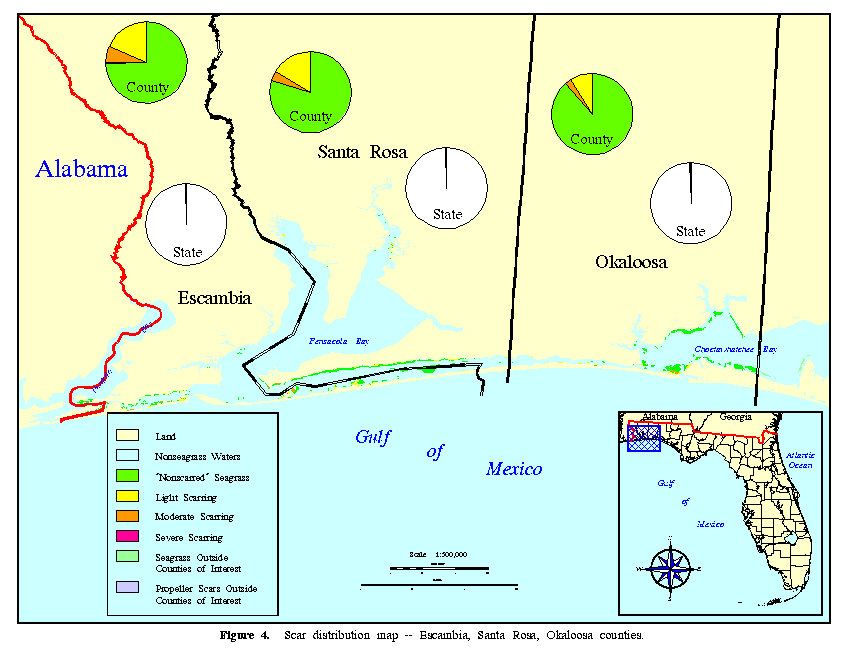

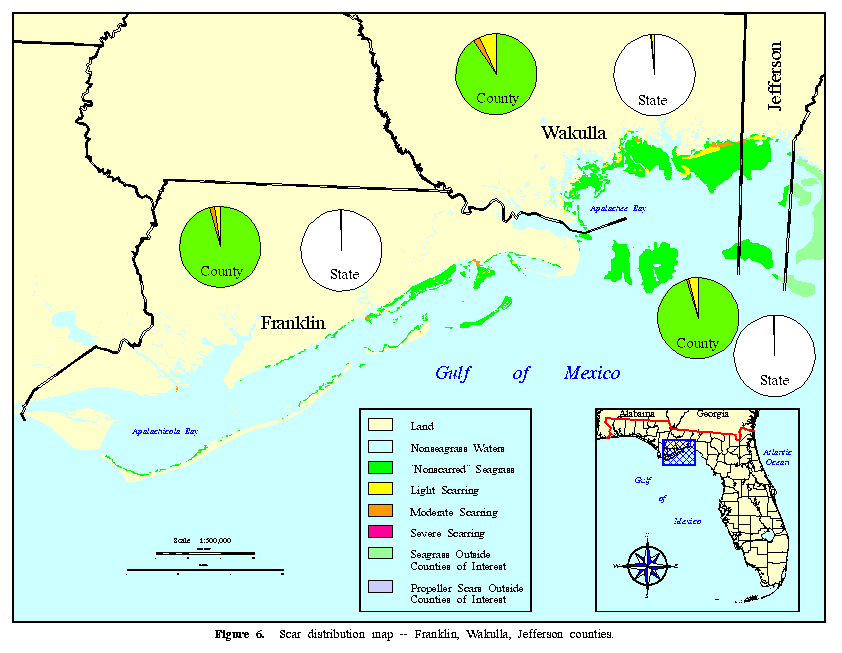
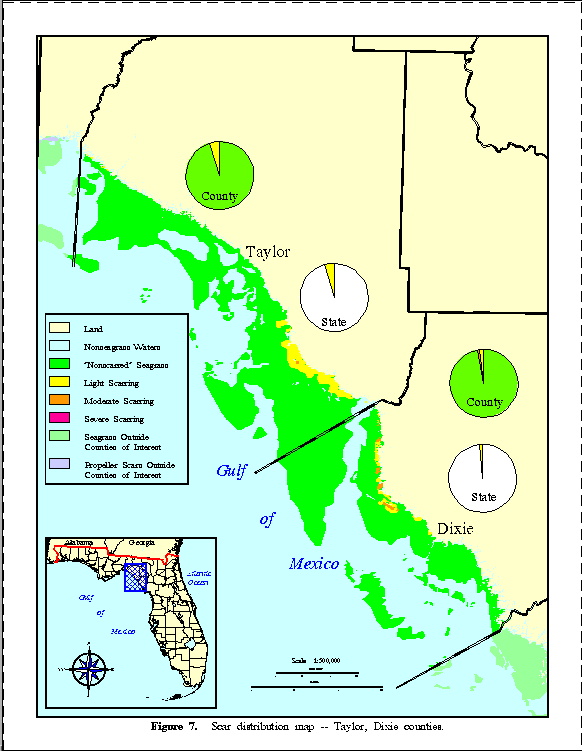
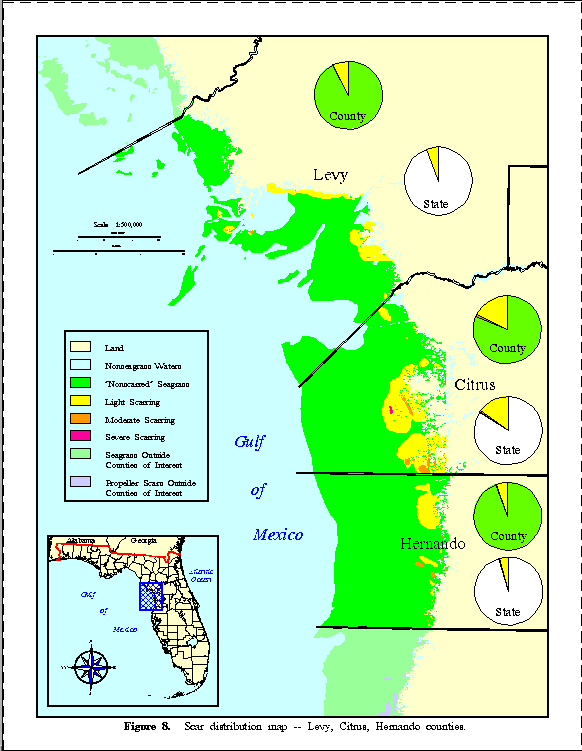
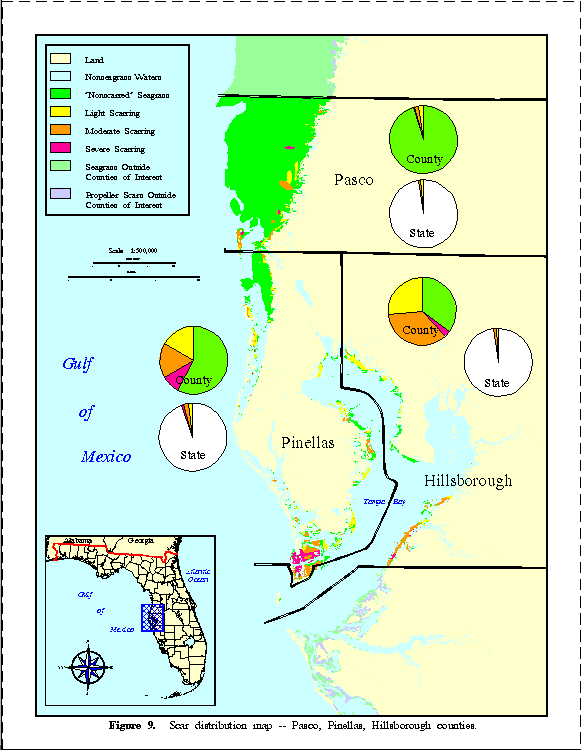
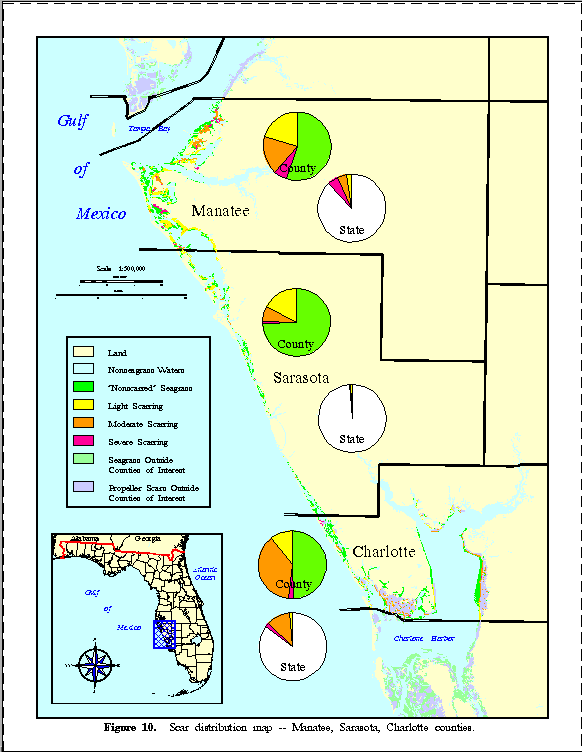
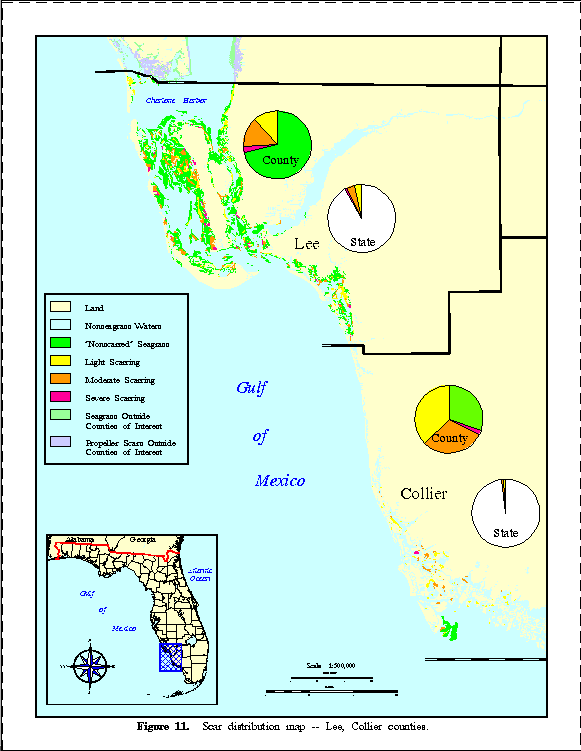
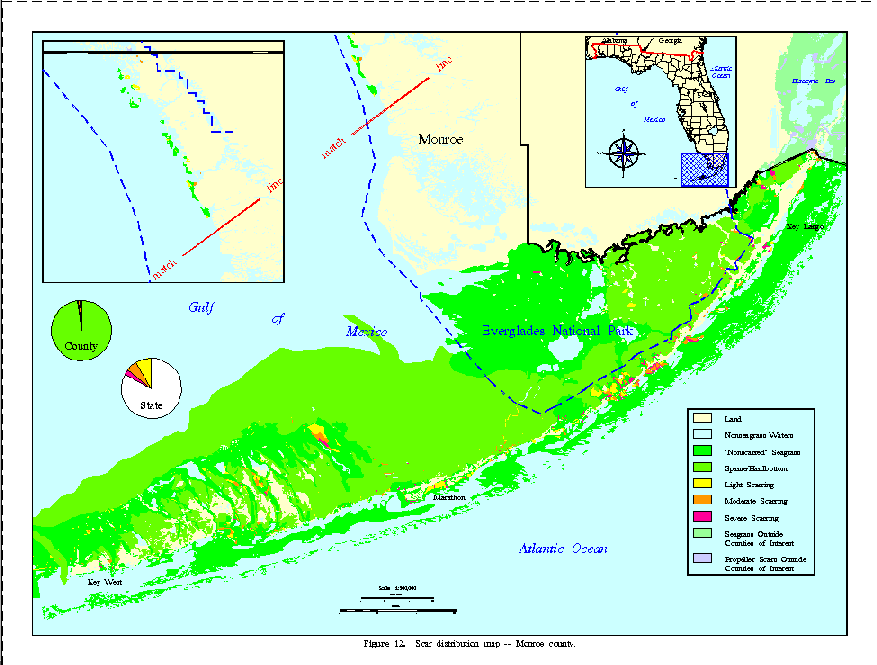
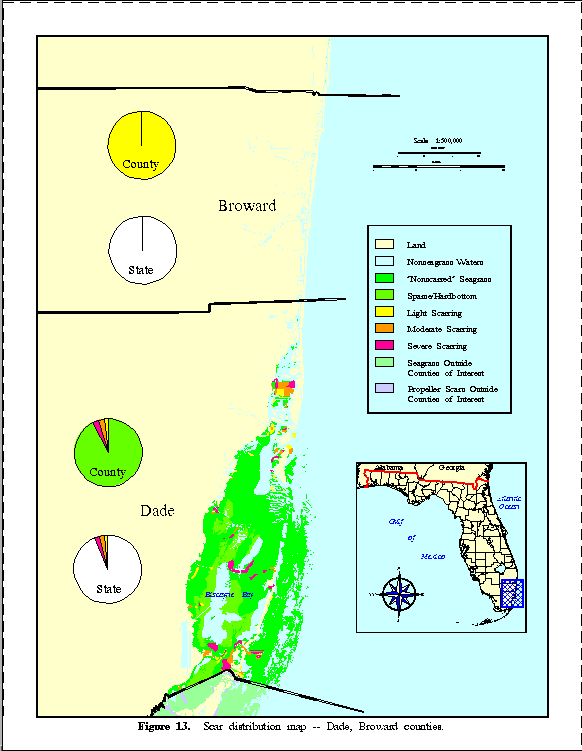
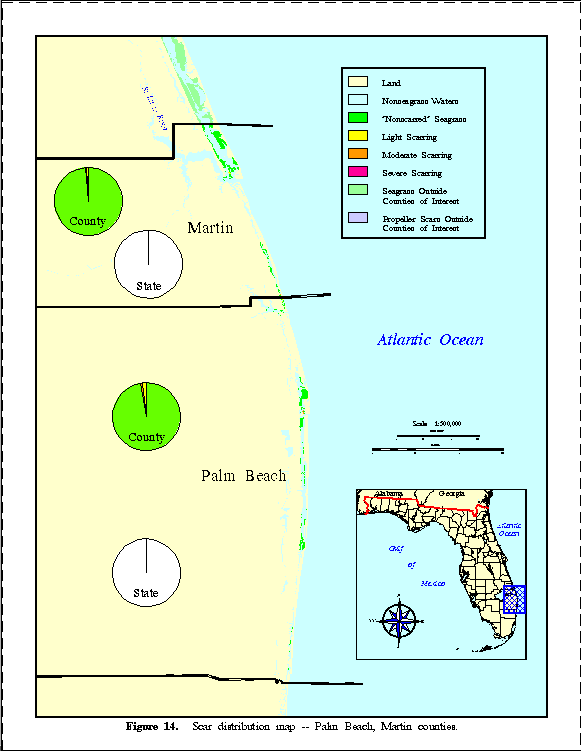
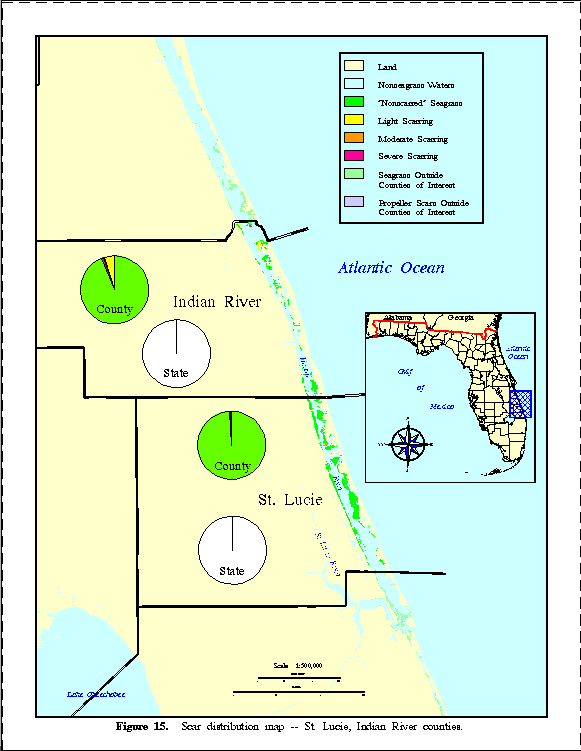
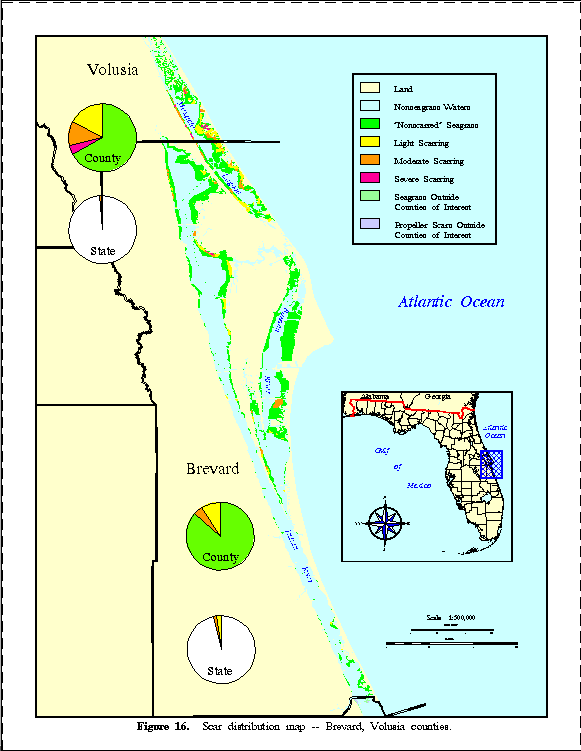
The remaining seagrass acreage (19 percent) is fairly evenly distributed among the other 25 counties, mostly in embayments and lagoonal systems. Twenty-two counties have less than 50,000 acres of seagrass, and the majority of those have less than 20,000 acres. The median seagrass acreage for the 31 coastal counties in this study is approximately 10,500 acres. After Monroe County (1,452,800 acres), Taylor county has the largest seagrass acreage (162,860 acres). Of the Florida counties that contain at least some seagrass, Broward County had the smallest acreage; approximately one acre of seagrass could be recognized from seagrass-distribution sources. The majority of Florida's moderate/severe (M/S) seagrass scarring (68.9 percent) occurred in five counties: Monroe, Dade, Lee, Charlotte, and Pinellas. These same counties contain 63.4 percent of the state's seagrass acreage. However, if Monroe County is excluded from analysis--because of its disproportionately large amount of seagrass acreage and scarring--the five counties that have the most M/S scarring contain only 9.3 percent of the state's seagrass acreage but 49.4 percent of its M/S scarring. For comparative purposes, then, counties must be ranked based on their percentages of scarring relative to scarring for the entire state. Relative to the whole state, the greatest amount of total scarring occurred, as would be expected from seagrass distributions, in Monroe and Citrus counties (Tables 3 and 4). Lee, Dade, Levy, and Pinellas counties also had substantial scarring. CONCLUSION Despite the limitations and assumptions of the methodology used, GIS and related technologies provided the necessary capabilities for a study of this nature and geographic extent. GIS analyses and products (both maps and tabular data) developed, provided needed information to resource managers, regional and county governments, and other interested parties. Management programs to control seagrass scarring have been implemented by several local governments. Additional programs are needed for counties that have severe scarring problems. Currently, the state manages scarring in only a few state parks (e.g., Lignumvitae Botanical Site and John Pennecamp Coral Reef State Park). A state-wide management program should be developed to protect seagrasses from scarring while still allowing for traditional water-related recreational and commercial activities. Combined with county programs, statewide management of scarring could effectively protect seagrass habitat. A single management approach, such as channel-marking alone, only partially addresses the problem of seagrass scarring. A combination of management techniques, along with long-term commitment, must be used to reduce the frequency and degree of scarring in seagrass beds. Some programs being implemented and tested use multifaceted approaches such as better educating the boating public, better marking of channels, limiting powerboat access in certain sensitive areas, and more effectively enforcing existing laws. Monitoring managed areas, both from the air and on site, is critical in determining the effectiveness of a management program. Nevertheless, preventing all seagrass scarring is impossible. With proper management, scarring can be reduced to a level that will reverse the cumulative damage to this critical resource. Although the data presented in this report are of a broad nature, the report provides a basis for further and more refined management of areas subject to an increase in seagrass- resource use. LITERATURE SITED Durako, M.J., M.O. Hall, F. Sargent, and S. Peck. 1992. Propeller scars in seagrass beds: an assessment and experimental study of recolonization in Weedon Island State Preserve, Florida. Pp. 42-53 in Webb, F. (ed.), Proceedings from the 19th Annual Conference of Wetlands Restoration and Creation. Hillsborough Community College. Tampa, FL. Haddad, K.D. and B.A. Harris. 1985. Assessment and trends of Florida's marine fisheries habitat: an integration of aerial photography and thematic mapper imagery. Pp. 130-138 in Anonymous (ed.), Proceedings of Machine Processing of Remotely Sensed Data with Special Emphasis on Quantifying Global Process: Models, Sensor Systems, and Analytical Methods. Lab. Appl. Remote Sensing, Purdue Univ., West Lafayette, IN. Kruer, C.R. 1994. Mapping assessment of vessel damage to shallow seagrasses in the Florida Keys. Final Rep. to Florida Dept. Nat. Res. and Univ. So. Florida Inst. Oceanog. F.I.O. Contract #47-10-123-L3. Lewis, R.R., III, M.J. Durako, and R.C. Phillips. 1985. Seagrass meadows of Tampa Bay - a review. Pp. 210-246 in Treat, S.-A. F., J.L. Simon, R.R. Lewis, III, and R.L. Whitman, Jr. (eds.), Proceedings Tampa Bay Area Scientific Information Symposium. Florida Sea Grant College Rep. 65. Gainesville, FL. Livingston, R.J. 1987. Historic trends of human impacts on seagrass meadows in Florida. Pp. 139-151 in Durako, M.J., R.C. Phillips, and R.R. Lewis, III (eds.). Proceedings of the Symposium on Subtropical-Tropical Seagrasses of the Southeastern United States. Fl. Mar. Res. Pub. 42. St. Petersburg, FL. 209 p. Terry, R.D. and G.V. Chilingar. 1955. Comparison charts for visual estimation of percent composition. Allen Hancock Foundation. Los Angeles, CA. Reprinted from J. Sed. Petrology 23:226-234.